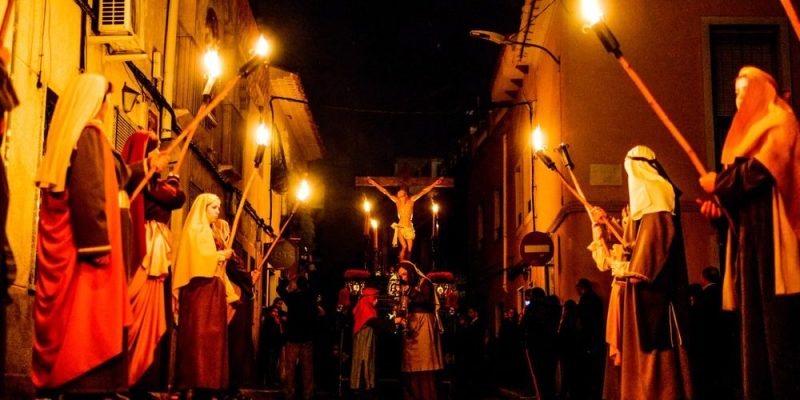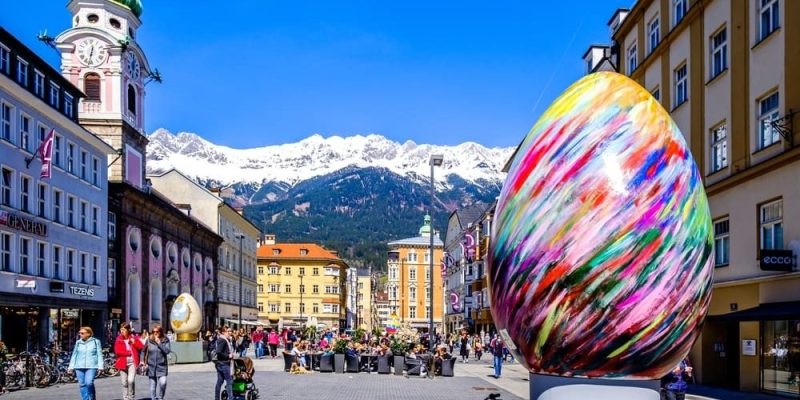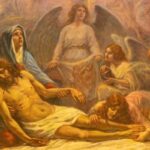We explain what Easter is for Christianity, its origin, history and meaning. In addition, we tell you what the Jewish Passover or Pesach is.

What is Easter?
Easter is a Christian holiday, also known as Easter, Easter, Easter Sunday or Resurrection Sunday. in it the resurrection of Jesus Christ is remembered on the third day of his crucifixion according to the story contained in the New Testament of the Christian Bible.
This is the celebration that ends Holy Week (which begins the previous Sunday, called Palm Sunday) and the Easter Triduum (which commemorates the passion, death and resurrection of Jesus from Holy Thursday to Easter Sunday). It takes place on a sliding date, which corresponds to the first full moon after the spring equinox in the northern hemisphere (March 21). Therefore, this date oscillates between March 22 and April 25 of each year in the calendar of the Catholic Church and the Protestant churches, and between April 4 and May 8 in the calendar of the Orthodox Church, which is governed by the old Julian calendar.
The way we commemorate Easter varies from one country to another and from one Christian tradition to another, but in general involves processions, liturgical celebrations, family gatherings and, in much of the West, the decoration and consumption of Easter eggs. Furthermore, the Easter season begins on Easter Sunday, a liturgical period of 50 days that ends on Pentecost Sunday, a day that, according to Christian tradition, commemorates the coming of the Holy Spirit and the beginning of the activities of the Church.
Easter It is the most important holiday in the Christian calendar since it commemorates the central episode of their religious belief: the resurrection of Jesus of Nazareth, which according to Christian tradition occurred in the Roman province of Judea, between the years 30 and 33 AD. c.
Despite this, Passover has important links with Jewish tradition, specifically with the Passover or the Jewish Passover, and in the biblical story, the death and resurrection of Jesus take place during the Jewish Passover.
Key points
- Easter, also called Easter Sunday, is a Christian religious holiday that commemorates the resurrection of Jesus Christ on the third day of his crucifixion.
- It marks the end of Holy Week and is celebrated on a moving date between March 22 and April 25 each year.
- It is celebrated through processions, liturgical celebrations, family gatherings and, in some countries, the decoration and consumption of Easter eggs.
- It has roots in the Jewish Passover (Pesach), which celebrates the liberation of the Hebrew people from slavery in Egypt, and is related to spring as a time of rebirth.
What is celebrated at Easter?

Easter Sunday is the day when Christians commemorate the resurrection of Jesus of Nazareth narrated in the New Testament. According to the biblical account, this would have occurred on the third day of his death, crucified on Mount Golgotha, also known as Calvary. According to this belief, the resurrection of Jesus fulfilled the prophecies expressed in the Old Testament about the coming of the Messiah.
Furthermore, Easter celebrates the revelation to the faithful of the divine plan for the salvation of humanity, that is, for the defeat of death and the eternal life of the spirit. Christian doctrine establishes that The death of Jesus Christ freed all human beings from their sins and renewed his alliance with God, his creator.
Origin and history of Easter
Like many other Christian traditions, Passover has important roots in Jewish tradition expressed in the Old Testament. Specifically in the celebration of Passoverthat is, the commemoration of the departure of the Hebrew people from Egypt (where, according to the biblical text, they lived in slavery) towards the Promised Land of Canaan, guided by the prophet Moses.
In this commemoration, Jews also remember the ten plagues with which God punished the Egyptian people, and in particular the leap that the angel of death made over the Hebrew houses when he went in search of the Egyptian firstborn. This “jump” was called in Hebrew passover (which expressed the idea of “passing over” the houses), a word that in liturgical Latin became pascha and later Passover due to similarity with the Latin term pascuumwhich refers to a place of pastures, that is, a place where the flock escapes hunger.
This transformation of the word was due to the expansion of Christianity during the times of the Roman Empire: According to Christian theology, when Jesus Christ resurrected he changed the meaning of Passover traditional jew and Easter came to represent the “leap” or passage from death to eternal life. In any case, in both cases it is a celebration of salvation and protection associated with the divine.
The Christian Easter began to be celebrated in chronological agreement with the Jewish Easter. It was done this way for some centuries, until the Council of Nicaea in 325 AD. C. it was decided to stop using the Hebrew calendar to calculate the date and it was decided to celebrate it on the first Sunday after the full moon that followed the spring equinox in the northern hemisphere (as was already done in the churches of Rome and Alexandria ). This was because Christians emphasized the significance of Sunday, which was the day of the week on which Jesus Christ was resurrected according to the Bible story, while the celebration of the Jewish Passover makes no distinction between the days of the week.
Meaning of Easter
The Christian Passover could be described as the Christian reinterpretation of the Jewish Passover. Not only because, according to Christian tradition, Jesus of Nazareth died and was resurrected during the Jewish Easter celebration, but also because The last supper that Jesus had with his apostles transformed the meaning of the traditional Easter dinner for his faithful since bread and wine were assigned an equivalence with the body and blood of Jesus Christ.
On the other hand, the sacrifice of the lamb that the Jews offered to God in the Temple of Jerusalem was replaced in Christian theology by the sacrifice on the cross of Jesus, called the “lamb of God” who through his immolation would have freed human beings from sin and sealed a new alliance between God and humanity. Furthermore, the death and resurrection of Jesus was important in this belief because It was considered to fulfill Old Testament prophecies about the arrival and sacrifice of the Messiah the “anointed” of God, which was considered a proof of the second coming of Christ and of God's coming judgment on Earth, in which those who did wrong would be punished and the righteous would be saved.
Finally, Easter in the northern hemisphere coincides with the arrival of spring, a season associated with rebirth and the end of the harshness of winter. Agricultural and pastoral peoples usually celebrate this event, as was the case in Europe when the spread of Christianity began, and possibly this favored the introduction of Easter as a holiday in the context of Christian evangelization during Late Antiquity and the Middle Ages.
Easter symbols

Christian Easter involves different traditional symbols:
- The paschal candle. The main symbol of Easter for Catholics is a large lit white candle, on which the letters alpha (⍺) and omega (⍵), the first and last of the Greek alphabet, are inscribed to symbolize the eternity of Christ. The light of this candle represents the hope of resurrection in the face of the darkness of suffering and death. Other elements that make up the Easter candle are the cross, five grains of incense that represent the five wounds of Christ, and the current year that symbolizes the presence of God in the present.
- The flowers. Easter coincides in the northern hemisphere with the arrival of spring, a time of rebirth in which everything turns green and plants bloom. This is expressed through the presence of flowers next to images of Christ and in various arrangements, which in this way also become symbols of the rebirth of Christ and hope in eternal salvation.
- Easter eggs. The origin of eggs as a symbol of Easter is uncertain, and it is not a custom shared by all Christian traditions. It is very common in Europe and America, and has some antecedents in the meaning that pagan peoples (as Christians called those who did not profess Christianity or Judaism) gave the egg as an emblem of fertility and rebirth. This symbol was incorporated into Christianity, and Easter eggs became a common gift, either decorated in different ways, or made of candy, dough or chocolate.
- The Easter Bunny. The rabbit was an animal associated with fertility and spring in some European peoples, and was adopted by the Christian tradition of some countries to represent the character who carried Easter eggs in a basket for children. This eventually led to the production of chocolate rabbits. There are also interpretations that associate the rabbit's emergence from its burrow at the end of winter with the concept of rebirth.
Jewish Passover
The Jewish Passover or Passover is the commemorating the liberation of the Hebrew people from their condition of slavery in Ancient Egypt and his departure towards the Promised Land (Canaan), as narrated in the book of Exodus of the Hebrew Bible or Tanakh, equivalent to the Old Testament of the Christian Bible.
It is one of the three pilgrimage festivals of Judaism (Shalosh Regalim), that is, those in which the Jews made a pilgrimage to the temple of Jerusalem when it had not yet been destroyed, to offer a sacrifice. According to the traditional Hebrew calendar, Pesach begins on the 15th of Nisan, and lasts for 7 days in Israel (8 in the diaspora) in which It is prohibited to consume foods derived from fermented cereals, and unleavened bread (without yeast) is eaten instead.
Also work stops, prayers are said and ritual foods are prepared especially for the seder, the family dinner that is celebrated on the first night and in which fragments about the Exodus taken from the Haggadah (a set of texts of Jewish tradition) are read.
References
- Hillerbrand, H.J. (2024). Easter. Encyclopedia Britannica. https://www.britannica.com/
- Johnson, P. (2017). History of Christianity. Editions B.
- Pikaza, X and Aya, A. (2009). Dictionary of the three religions: Judaism, Christianity, Islam. divine word.
- The Editors of Encyclopaedia Britannica. (2024). Passover. Encyclopedia Britannica. https://www.britannica.com/





